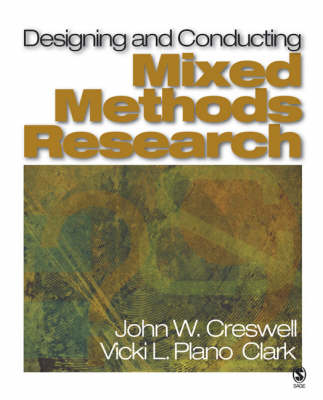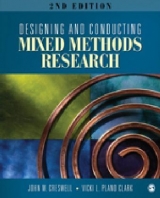
Designing and Conducting Mixed Methods Research
SAGE Publications Ltd (Verlag)
978-1-4129-2792-5 (ISBN)
- Titel ist leider vergriffen;
keine Neuauflage - Artikel merken
Mixed method research design, spearheaded by the author of the best-selling Research Design text (Second Edition, SAGE 2002), combines the latest thinking about mixed methods research designs with practical, step-by-step guidelines for the decisions that must be made in designing a mixed methods research study. The text: - offers a practical, how-to guide for designing a mixed methods study - presents examples from actual, published mixed methods studies drawn across the social, behavioural, health, and education disciplines - incorporates activities and exercises for classroom use or for use by the researcher in preparing designs - contains a full glossary of terms for quick reference or as a study tool - illustrates designs using visual diagrams and flowcharts - goes through the entire research process (formulating questions, designing, collecting, interpreting, etc.) using four major types of mixed methods designs Mixed methods research is defined as a procedure for collecting, analyzing, and mixing both quantitative and qualitative data in a single case study or series of studies and is becoming more common in studies across the social, behavioural, and health sciences as well as education.
Vicki L. Plano Clark, Ph.D., is a research assistant professor in the Department of Educational Psychology, co-director of the Office of Qualitative and Mixed Methods Research, and managing editor of the new Journal of Mixed Methods Research (Sage Publications) at the University of Nebraska-Lincoln (UNL). Her specialization includes mixed methods research designs and qualitative research. She is interested in the procedural issues that arise when implementing different designs and how mixed methods research is applied in different disciplines. She has co-authored numerous methodological discussions as well as empirical studies using qualitative and mixed methods approaches in science education, family research, and family medicine. In addition, she served as the Laboratory Manager in the UNL Department of Physics and Astronomy (1993-2005), working with the Research in Physics Education Group, and was a principal investigator on three National Science Foundation projects. John W. Creswell is a Professor of Educational Psychology at Teachers College, University of Nebraska-Lincoln. He is affiliated with a graduate program in educational psychology that specializes in quantitative and qualitative methods in education. In this program, he specializes in qualitative and quantitative research designs and methods, multimethod research, and faculty and academic leadership issues in colleges and universities.
List of Tables List of Figures Preface Purpose of This Book Audience for the Book Book Features Acknowledgments Chapter 1: Understanding Mixed Methods Research Purpose and Organization Clarifying Terms What Is Mixed Methods Research? The Importance of Mixed Methods Research Summary Activities Additional Resources to Examine Chapter 2: Examining Preliminary Considerations Consider Worldview Stances The Basics of Quantitative and Qualitative Research Research Problems Addressed by Mixed Methods Summary Activities Additional Resources to Examine Chapter 3: Locating and Reviewing Mixed Methods Studies Searching for and Reviewing Mixed Methods Studies A Mixed Methods Notation System and Visual Diagrams Four Examples of Mixed Methods Studies Summary Activities Additional Resources to Examine Chapter 4: Choosing a Mixed Methods Design Classifications of Mixed Methods Designs The Four Major Types of Mixed Methods Designs Selecting a Type of Mixed Methods Design Implementing the Design Decisions Writing a Paragraph to Identify a Study's Design Summary Activities Additional Resources to Examine Chapter 5: Introducing a Mixed Methods Study Writing a Mixed Methods Title Stating the Problem in the Introduction The Purpose Statement Research Questions and Hypotheses Summary Activities Additional Resources to Examine Chapter 6: Collecting Data in Mixed Methods Research Procedures in Qualitative and Quantitative Data Collection Data Collection in Mixed Methods Design Summary Activities Additional Resources to Examine Chapter 7: Analyzing Data in Mixed Methods Research Procedures in Quantitative and Qualitative Data Analysis Data Analysis With Mixed Methods Designs Summary Activities Additional Resources to Examine Chapter 8: Writing and Evaluating Mixed Methods Research General Guidelines for Writing Organize the Structure of the Writing So That It Relates to the Designs Evaluating a Mixed Methods Study Within Designs Summary Activities Additional Resources to Examine Chapter 9: Questions Often Raised About Mixed Methods Research Anticipate Mixed Methods Questions What Is Mixed Methods Research? Is Mixed Methods Research Accepted? Is Mixed Methods Research Realistic? Summary Activities Additional Resources to Examine Chapter 10: Future Directions for Mixed Methods Research Needed Developments in Mixed Methods Research Summary Activities Additional Resources to Examine Appendix A. A Triangulation Design Appendix B. An Embedded Design Appendix C. An Explanatory Design Appendix D. An Exploratory Design References Index About the Authors
| Erscheint lt. Verlag | 26.9.2006 |
|---|---|
| Zusatzinfo | Illustrations |
| Verlagsort | London |
| Sprache | englisch |
| Maße | 187 x 232 mm |
| ISBN-10 | 1-4129-2792-7 / 1412927927 |
| ISBN-13 | 978-1-4129-2792-5 / 9781412927925 |
| Zustand | Neuware |
| Haben Sie eine Frage zum Produkt? |
